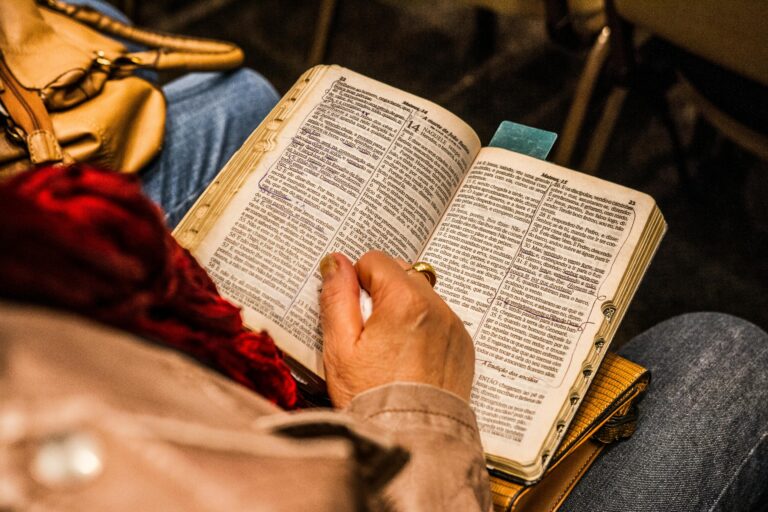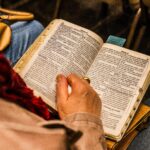To God Be The Glory!
I remember staring at my Bible one morning, coffee in hand, feeling completely overwhelmed. Where should I start? How could I make sense of what I was reading? That’s when I discovered the HEAR Bible study method, and it transformed my entire approach to Scripture. Today, I’m excited to share this simple but powerful method that helped me move from simply reading the Bible to truly understanding and applying it to my life.
What is the HEAR Bible Study Method?

Before I dive into the details, let me break down what HEAR stands for:
- H – Highlight
- E – Explain
- A – Apply
- R – Respond
This method has become my daily companion, and I love it because it’s both structured enough to keep me focused and flexible enough to accommodate my busy schedule (trust me, with three kids and a full-time job, I need that flexibility!).
Getting Started: What You’ll Need
Let me share what’s in my daily Bible study toolkit:
- A Bible (I use NIV, but use whatever translation speaks to you)
- A journal or notebook (I use a simple spiral notebook)
- Favorite pens or highlighters (I’m partial to my collection of colored pens)
- Your favorite hot beverage (coffee is my must-have!)
- 15-30 minutes of quiet time
Breaking Down the HEAR Method: My Step-by-Step Approach
H – Highlight
Remember when you were in school and highlighted important passages in your textbooks? This is similar, but much more meaningful. Here’s what I do:
- I start by writing the date and the Bible passage I’m reading
- As I read, I look for:
- Verses that speak to my current situation
- Words or phrases that repeat
- Commands or promises
- Words I don’t understand
Personal Example: Just last week, I was reading Philippians 4:6-7, and the phrase “do not be anxious about anything” jumped out at me. I was preparing for a big presentation at work, and these words felt like they were written just for me!
E – Explain
This is where I put on my detective hat and ask questions about the text. I write down:
- What’s happening in this passage?
- Who is involved?
- Where and when is this taking place?
- Why did the author write this?
My Approach: I keep a section in my journal titled “What I Learned Today” where I write these explanations in my own words. Sometimes I even draw little diagrams or mind maps (they’re not artistic masterpieces, but they help me understand!).
A – Apply
This is my favorite part because it’s where Scripture becomes real in my daily life. I ask myself:
- How does this truth apply to my life today?
- What changes do I need to make?
- What steps can I take to live out this message?
Real-Life Example: When studying Matthew 6:25-34 about worry, I realized I was spending hours anxious about future events I couldn’t control. This led me to create a “God’s Got This” list where I write down my worries and surrender them in prayer.
R – Respond
This final step is where I get practical and personal. I write out:
- A prayer related to what I’ve learned
- Specific actions I’ll take
- Things I need to confess or change
- People I need to talk to or forgive
Personal Practice: I keep a small section in my planner called “Today’s Response” where I write one actionable step from my Bible study. Yesterday’s was “Call Mom and apologize for being short with her on the phone.”
My Weekly HEAR Study Routine
Here’s how I structure my week:
- Monday: Old Testament passages
- Tuesday: Psalms
- Wednesday: Proverbs
- Thursday: Gospels
- Friday: New Testament letters
- Saturday: Catch-up day
- Sunday: Church sermon notes
Tips from My Learning Curve
- Start Small
I made the mistake of trying to study entire chapters at first. Now I focus on shorter passages and get more out of them. - Be Consistent
My best time is 6:00 AM before my kids wake up. Find your sweet spot and protect it! - Keep It Simple
Some days my HEAR study fits on one journal page, other days it flows onto three pages. Both are perfectly fine! - Use Technology Wisely
I use the YouVersion Bible app for reading plans, but I write my HEAR study by hand – there’s something special about putting pen to paper.
Common Challenges (and How I Overcome Them)
“I Don’t Have Time”
I started with just 15 minutes during my lunch break. Now it’s naturally grown to 30 minutes because I love this time so much.
“I Don’t Understand What I’m Reading”
When this happens (and it still does!), I:
- Read the passage in a different translation
- Look up background information in my study Bible
- Discuss it with my small group
“I Keep Getting Distracted”
My solution:
- Phone on “Do Not Disturb”
- Study space away from my computer
- Early morning when the house is quiet
Making It Your Own
Remember, this is a method, not a straightjacket. I’ve adapted it over time to work for me, and you should too! Some days I spend more time on one step than others, and that’s perfectly okay.
Getting Started Today
Here’s my challenge to you: Start with just one verse. I suggest Philippians 4:13 or Psalm 23:1. Use the HEAR method to study it, and I promise you’ll discover something new, even in familiar verses.
Sample HEAR Entry from My Journal

Conclusion
The HEAR method has become more than just a Bible study technique for me – it’s my daily conversation with God. It helps me slow down, digest His Word, and actually live it out. Whether you’re new to Bible study or looking for a fresh approach, I encourage you to give it a try. Start small, be consistent, and watch how God’s Word comes alive in new ways.
Remember, the goal isn’t perfection – it’s progress and relationship. We’re all on this journey together, and every day brings new insights and growth opportunities.
“Your word is a lamp for my feet, a light on my path.” – Psalm 119:105
Want to start your HEAR journey? Join me! Pick a verse, grab your journal, and let’s discover God’s truth together.







